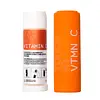What's inside
What's inside
 Key Ingredients
Key Ingredients

 Benefits
Benefits

 Concerns
Concerns

 Ingredients Side-by-side
Ingredients Side-by-side

Water
Skin ConditioningNiacinamide 5%
SmoothingGlycerin
HumectantPropylene Glycol
HumectantAscorbyl Tetraisopalmitate 2%
AntioxidantCetearyl Ethylhexanoate
EmollientCaprylic/Capric Triglyceride
MaskingTocopheryl Acetate
AntioxidantFerulic Acid 1%
AntimicrobialUbiquinone
AntioxidantBetaine
HumectantSodium Rna
Skin ConditioningSodium Lactate
BufferingSerine
MaskingAlanine
MaskingGlycine
BufferingGlutamic Acid
HumectantLidocaine Hcl
Threonine
Arginine
MaskingProline
Skin ConditioningLecithin
EmollientSodium Acrylic Acid/Ma Copolymer
Sodium Polyacrylate
AbsorbentTetrasodium EDTA
Tocopherol
AntioxidantBeta-Sitosterol
Emulsion StabilisingSqualene
EmollientGlyceryl Linolenate
EmollientEthylhexylglycerin
Skin ConditioningPhenoxyethanol
PreservativeWater, Niacinamide 5%, Glycerin, Propylene Glycol, Ascorbyl Tetraisopalmitate 2%, Cetearyl Ethylhexanoate, Caprylic/Capric Triglyceride, Tocopheryl Acetate, Ferulic Acid 1%, Ubiquinone, Betaine, Sodium Rna, Sodium Lactate, Serine, Alanine, Glycine, Glutamic Acid, Lidocaine Hcl, Threonine, Arginine, Proline, Lecithin, Sodium Acrylic Acid/Ma Copolymer, Sodium Polyacrylate, Tetrasodium EDTA, Tocopherol, Beta-Sitosterol, Squalene, Glyceryl Linolenate, Ethylhexylglycerin, Phenoxyethanol
Water
Skin Conditioning3-O-Ethyl Ascorbic Acid 15%
Skin ConditioningGlycerin
HumectantLactobacillus/Punica Granatum Fruit Ferment Extract
Skin ConditioningAscorbyl Tetraisopalmitate 3%
AntioxidantTrehalose
HumectantDi-C12-13 Alkyl Malate
EmollientCetearyl Alcohol
EmollientPhosphatidylcholine
EmulsifyingDimethicone
EmollientC12-13 Alkyl Lactate
EmollientCyclopentasiloxane
EmollientPhenoxyethanol
PreservativeAmmonium Acryloyldimethyltaurate/Vp Copolymer
Tocopheryl Acetate
AntioxidantPotassium Cetyl Phosphate
EmulsifyingBis-Ethylhexyl Hydroxydimethoxy Benzylmalonate
AntioxidantMethylparaben
PreservativeEthylparaben
PreservativePropylparaben
PreservativeAlgin
MaskingLactic Acid
BufferingSuccinic Acid
BufferingWater, 3-O-Ethyl Ascorbic Acid 15%, Glycerin, Lactobacillus/Punica Granatum Fruit Ferment Extract, Ascorbyl Tetraisopalmitate 3%, Trehalose, Di-C12-13 Alkyl Malate, Cetearyl Alcohol, Phosphatidylcholine, Dimethicone, C12-13 Alkyl Lactate, Cyclopentasiloxane, Phenoxyethanol, Ammonium Acryloyldimethyltaurate/Vp Copolymer, Tocopheryl Acetate, Potassium Cetyl Phosphate, Bis-Ethylhexyl Hydroxydimethoxy Benzylmalonate, Methylparaben, Ethylparaben, Propylparaben, Algin, Lactic Acid, Succinic Acid
Ingredients Explained
These ingredients are found in both products.
Ingredients higher up in an ingredient list are typically present in a larger amount.
Ascorbyl Tetraisopalmitate is a version of ascorbic acid, or Vitamin C.
This ingredient has many benefits including reducing wrinkles, skin soothing, dark spot fading, and fighting against free radicals.
It helps with dark spot fading by interfering with the process of skin darkening, helping to reduce hyperpigmentation. Like other forms of vitamin C, this ingredient encourages the skin to create more collagen.
As an antioxidant, it helps fight free-radicals. Free-radicals are molecules that may damage your skin cells.
One study found Ascorbyl Tetraisopalmitate to degrade in sunlight, but is stabilized when combined with acetyl zingerone.
Learn more about Ascorbyl TetraisopalmitateGlycerin is already naturally found in your skin. It helps moisturize and protect your skin.
A study from 2016 found glycerin to be more effective as a humectant than AHAs and hyaluronic acid.
As a humectant, it helps the skin stay hydrated by pulling moisture to your skin. The low molecular weight of glycerin allows it to pull moisture into the deeper layers of your skin.
Hydrated skin improves your skin barrier; Your skin barrier helps protect against irritants and bacteria.
Glycerin has also been found to have antimicrobial and antiviral properties. Due to these properties, glycerin is often used in wound and burn treatments.
In cosmetics, glycerin is usually derived from plants such as soybean or palm. However, it can also be sourced from animals, such as tallow or animal fat.
This ingredient is organic, colorless, odorless, and non-toxic.
Glycerin is the name for this ingredient in American English. British English uses Glycerol/Glycerine.
Learn more about GlycerinPhenoxyethanol is a preservative that has germicide, antimicrobial, and aromatic properties. Studies show that phenoxyethanol can prevent microbial growth. By itself, it has a scent that is similar to that of a rose.
It's often used in formulations along with Caprylyl Glycol to preserve the shelf life of products.
Tocopheryl Acetate is AKA Vitamin E. It is an antioxidant and protects your skin from free radicals. Free radicals damage the skin by breaking down collagen.
One study found using Tocopheryl Acetate with Vitamin C decreased the number of sunburned cells.
Tocopheryl Acetate is commonly found in both skincare and dietary supplements.
Learn more about Tocopheryl AcetateWater. It's the most common cosmetic ingredient of all. You'll usually see it at the top of ingredient lists, meaning that it makes up the largest part of the product.
So why is it so popular? Water most often acts as a solvent - this means that it helps dissolve other ingredients into the formulation.
You'll also recognize water as that liquid we all need to stay alive. If you see this, drink a glass of water. Stay hydrated!
Learn more about Water